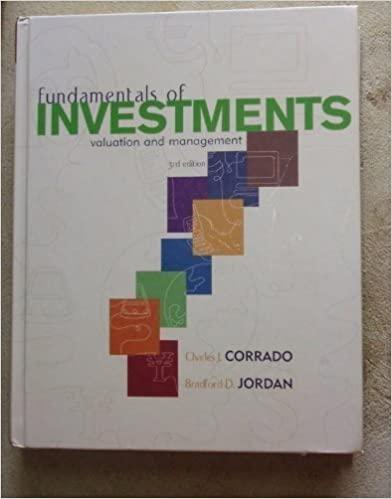Question
1. Show working. A stock is currently priced at $30 and is expected to pay a dividend of $0.60 in 20 days and $0.65 in
1. Show working. A stock is currently priced at $30 and is expected to pay a dividend of $0.60 in 20 days and $0.65 in 180 days from now. The contract price for a 60-day forward contract when the annualized interest rate is 2% is closest to (assume a 365-day year):
A. $29.40
B. $29.50
C. $29.60
D. $30.00
2. Gamma measures:
A. The rate of change of delta with respect to the asset price.
B. The rate of the change of the portfolio value with respect to the passage of time.
C. The sensitivity of the portfolio value with respect to interest rate changes.
D. None of the above.
3. If gold is selling at $1,200 and a futures contract maturing in one year is trading for $1,250, which of the following is a successful arbitrage opportunity? Assume the interest rate is 2%.
A. Short the gold, invest the proceeds at 2% and long the future contract now; buy back the gold next year for $1,250.
B. Borrow $1,250 and long the futures contract now; buy the gold next year for $1,250.
C. Borrow $1,200, buy the gold and short the futures now; sell the gold next year for $1,250.
D. None of the above.
4. Show working. A portfolio manager expects to receive funds from a new client in 30 days. These funds are to be invested in a basket of equities. He decides to take a long position in 30-day forward contracts on the S&P 500 stock index to hedge against an increase in equity prices. The index is currently at 2,440. The continuously compounded dividend yield on the index is 1.90%, and the continuously-compounded risk-free rate is 2%. Assuming a 365-day year, what is the forward price on the index?
A. $2,440.00
B. $2,440.20
C. $2,440.80
D. none of the above.
5. Vega measures:
A. The rate of change of delta with respect to the asset price.
B. The rate of the change of the portfolio value with respect to the passage of time.
C. The sensitivity of the portfolio value with respect to interest rate changes.
D. None of the above.
6. Which of the following statements about the implied volatility is incorrect?
A. it often differs across options with different strike prices.
B. it is determined by trial and error.
C. it equals the historical volatility if the option price on the market is equal to the Black-Scholes price.
D. None of the above.
7. A put option has a delta of -0.3. A trader has bought 1000 options and wants to create a delta-neutral position.
(i) Should the trader take a long or short position in the asset?
A. Long
B. Short
(ii) How many units of the asset should be bought or sold?
A. 300
B. 333
C. 1,000
D. 3,000
Step by Step Solution
There are 3 Steps involved in it
Step: 1

Get Instant Access to Expert-Tailored Solutions
See step-by-step solutions with expert insights and AI powered tools for academic success
Step: 2

Step: 3

Ace Your Homework with AI
Get the answers you need in no time with our AI-driven, step-by-step assistance
Get Started


